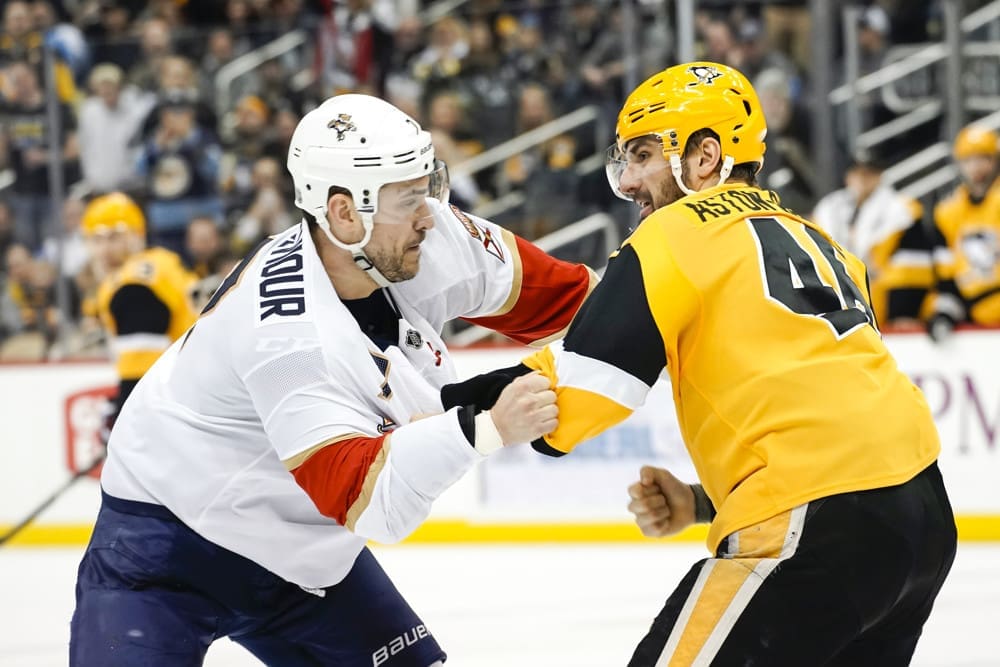Penguins
Penguins Endure Consequences, Is Fighting Still ‘Part of Game’?

The Pittsburgh Penguins went without defenseman Jamie Oleksiak after Washington Capitals forward Tom Wilson decided to answer the bell even before it was rung and the Penguins will presumably go without Zach Aston-Reese for a few weeks after the winger broke his hand on Colton Sceviour’s hard head. Yet it doesn’t sound like the consequential injuries will deter the Penguins or head coach Mike Sullivan.
Wilson got the jump on Oleksiak who didn’t set for the fight and was concussed. Though Oleksiak is now cleared to play, he appears to have lost his spot to gritty Finnish rookie Juuso Riikola.
Aston-Reese had to answer for a late hit he made, and for which he was penalized. As the Penguins and Florida Panthers devolved from chippy into cheap, Aston-Reese pounded Sceviour’s head. It may have hurt the Florida combatant for a few minutes, but it will hurt the Penguins for a few weeks.
A former grinder himself, Sullivan shrugged off a question about fighting’s legitimacy in the NHL.
“We play a game that is belligerent in nature. That’s part of the game,” he dismissed. “Guys are competing hard. They’re sticking up for one another and I think that’s part of the game.”
Opinion and Analysis
And Sullivan is correct. With the salary cap, increasing speed and need for skill prevent teams from stocking ham-handed big guys whose sole purpose is to punch someone, fighting is waning. And only a few players around the league don’t wear visors, which further complicates the pugilistic element in hockey.
Make no mistake, fighting is still a part of the game…when properly used. And there
The Penguins injuries are prime examples of proper and improper fights and the dangers of novice knuckle throwers.
Show me a Penguins fan who didn’t want to see Jamie Oleksiak knock the stuffing out of Tom Wilson but Oleksiak was caught by Wilson, who is far more experienced with the dark arts. Depending on which side of the fence, perhaps which side of the border you sit, Oleksiak either should have been more ready for the fight with Wilson or Wilson took an unfair advantage by being the surprise aggressor.
The Canadian element largely thought Oleksiak should have been more ready.
The backstory is Wilson declined to answer the bell in Round 2 after he annihilated Aston-Reese with a vicious head-shot and then was seen laughing on the bench (there is some dispute if Wilson was laughing at Aston-Reese but the optics were awful).
The fight was proper but improperly executed and resulted in an unfortunate injury.
The Aston-Reese Sceviour fight was an example of an unnecessary scrap. Take a note from Wilson’s experience. Wilson knew that fighting Oleksiak in Round 2 would have given the Penguins a boost. He declined it. He took the heat and won.
There just wasn’t any good reason for Aston-Reese to fight a Florida Panther. Florida isn’t competitive in the standings. Nor was it a matter of protecting a star teammate from harm. Instead, it was an old school answer for a rough play. The risks far outweighed the benefit and now the Penguins are dealing with the consequences.
Aston-Reese should have declined.
The Penguins fourth line was able to shelter Sidney Crosby. By picking up hard defensive minutes against top lines–talk about old school–the Penguins fourth line lessened the burden on Crosby which in turn has the Penguins star on pace for over 100 points. It’s also allowed Crosby to kill penalties, which has transformed their PK unit into a dangerous entity.
And now–that’s gone for a few weeks, just as the Penguins were hitting their stride.
Fighting is still necessary to protect teammates and assert yourself in a physical environment. But the dangers can’t be ignored. If a player doesn’t know what he’s doing–don’t do it. If there isn’t a legitimate reason–don’t do it. Leave the fighting to players who know what they’re doing or learn how to do it well.
That’s the lesson. Fighting will probably go away within the next generation, organically. Like the dropkick in football. But for now, it’s still a necessary evil and the best way to avoid the dangers is to be prepared.












